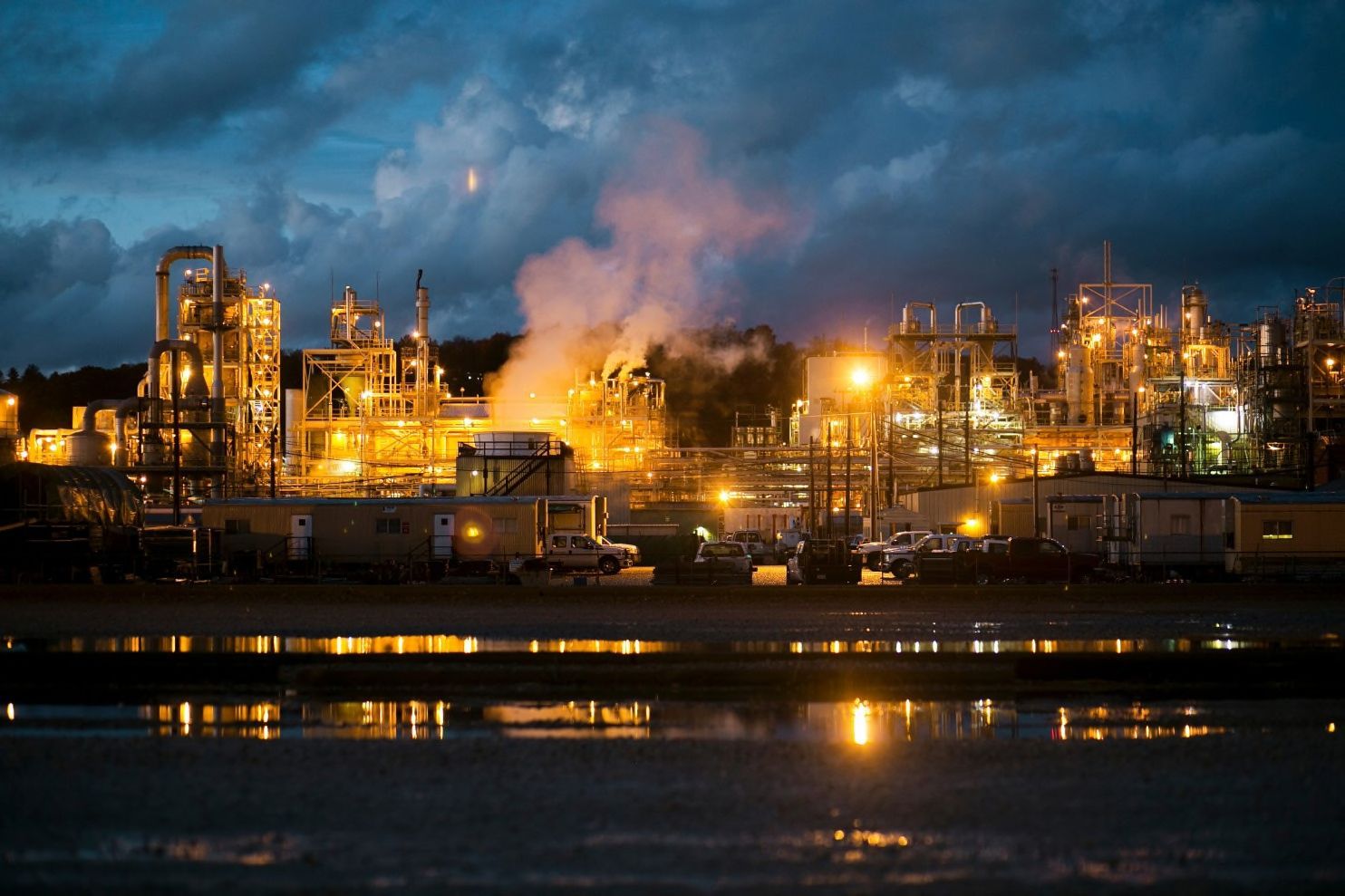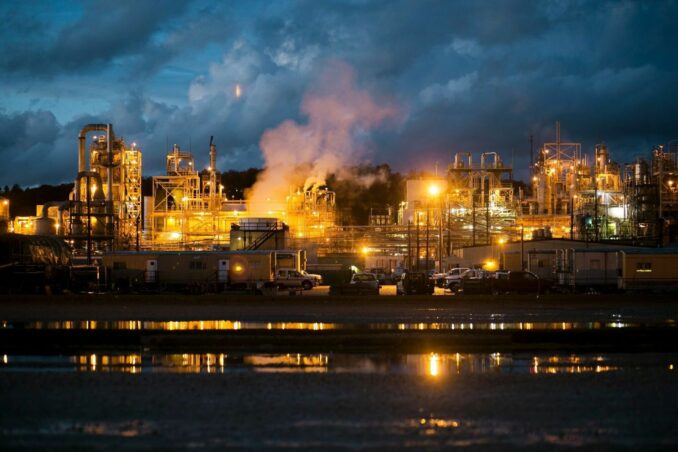

DuPont’s Washington Works, Parkersburg, West Virginia
What’s in your water? Can you trust that paper wrapped around your take-out sandwich — or the plastic clamshell — not to contaminate your food? Just what makes your carpet stain-resistant? Should you finally toss out that old Teflon pan?


DuPont’s Washington Works, Parkersburg, West Virginia
While seemingly unrelated, these questions stem from recent revelations that “forever chemicals” — used to coat that paper wrap, plastic package, nonstick cookware, in most stain- and water-resistant products, and in flame retardants, cosmetics and even dental floss — contain high levels of carcinogenic chemicals.
The omnipresent forever chemicals involve several thousand synthetic chemicals known as PFAS — polyfluoroalkyl substances — that repel oil and water and withstand heat. Over time, these chemicals build up in the bodies of people and animals. Unleashed in the environment, they take hundreds of years or longer to break down.
There are over 9,000 known PFAS compounds, with 600 used in the U.S. The Centers for Disease Control and Prevention found PFAS in the blood of most people they tested, raising concerns over widespread public exposure.
In January 2021, Scientific American magazine reported on a study by the Environmental Working Group that found the drinking water of most people in the U.S. likely contains forever chemicals. Widely used, released and carelessly disposed of over decades, PFAS are found virtually everywhere in the soil, in the water we drink and even the air we breathe.
Numerous studies show that when these chemicals leach into food and water, they cause cancer, liver disease, kidney problems, decreased immunity, birth defects and other health problems. DuPont, 3M and other chemical companies which manufacture these products have known this for decades.
Manhattan Project connection
DuPont’s Teflon was first developed for use during World War II in the Manhattan Project, which created warheads, liquid-fuel tanks and the atomic bombs that devastated Hiroshima and Nagasaki. Ever on the lookout for more profits, DuPont quickly found a use for these war-related chemical compounds in mass-produced consumer goods.
In the 1950s, several Manhattan Project researchers joined 3M, when that company began to commercially produce PFAS chemicals. Best known for the PFAS-based water and stain repellent Scotchgard, the company agreed in 2000 to stop making PFAS chemicals but declined to declare them hazardous.
On Nov. 19, bipartisan legislation was introduced in Congress to ban PFAS in U.S. food packaging. Its passage is far from certain, given anticipated opposition from the chemical industry. A similar bill passed by the House in 2020 was blocked by a Senate filibuster.
Earlier that week, the Environmental Protection Agency released draft reports on two forever chemicals — PFOA (perfluoro octanoic acid) and PFOS (perfluoro octane sulfonic acid) — found to be “more toxic than previously reported.” The EPA labeled them “likely carcinogenic to humans” and aims to establish drinking water limits for PFOA and PFOS by 2023.
The EPA has known of the harm caused by these chemicals for decades and done very little about it. Even extremely low levels of PFAS have long been associated with a wide range of health problems. Yet the EPA lets companies producing PFAS set their own contamination levels.
Deadly contamination
There is no federal drinking water standard to test if PFAS chemicals are causing harm. But under the 1976 Toxic Substances Control Act, the EPA must demonstrate evidence of harm before it can test a chemical. In the last 40 years, the EPA has restricted just five out of tens of thousands of chemicals.
Contaminant concentration in drinking water is measured as parts per million (ppm) and parts per billion (ppb). PFAS are measured in parts per trillion (ppt) — the equivalent of one drop of water in 20 Olympic size swimming pools.
Independent research has found contamination levels higher than one part per trillion of these chemicals can increase the risk of testicular cancer, liver tumors, high cholesterol and other health problems. At 10 ppt, upwards of 80 million people in the U.S. risk exposure. Yet in a statement to Scientific American, the industry-based American Chemistry Council claimed there was no scientific basis for setting contaminant levels lower than 70 ppt.
Who is regulating the PFAS danger?
While the Trump administration pushed back against any efforts to regulate PFAS and promised to veto any legislation to regulate the chemical industry, presidential candidate Joe Biden outlined detailed campaign promises to control and regulate the contamination.
To ensure passage of the legislation introduced Nov. 19, President Biden could circumvent any filibuster by issuing an executive order setting limits on PFAS contaminant levels in drinking water — or even ban their production.
There is little evidence he will do so. Biden’s political career originated in DuPont-controlled Delaware. He is just another politician in DuPont’s pockets.
And whether under a Republican or Democratic administration, there has been little change in the EPA’s ability to regulate the chemical industry’s 70-plus years of production of PFAS. The industry controls politicians on both sides of the aisle.
DuPont’s decades of duplicity
In 1951, DuPont opened a major facility in Parkersburg, West Virginia, to manufacture Teflon. By 1961 the company knew that PFOA, used in Teflon, was toxic. Over the decades DuPont pumped hundreds of thousands of pounds of PFOA powder into the Ohio River and over 7,000 tons of PFOA-laced sludge into open, unlined storage ponds.
As chemicals seeped into the ground, PFOA entered the local water table, which supplied drinking water for over 100,000 area residents.
In the 1970s, DuPont found high levels of PFOA in the blood of its factory workers but failed to notify the EPA. In the 1980s they established links between PFOA contamination and birth defects, after testing the children of pregnant workers in their Teflon division — of seven births, two had eye defects.
In 1984 the company found PFOAs in dust ventilated from its factory chimneys, which spread far beyond the plant’s boundaries. In 1991 DuPont scientists suggested an internal safety limit for PFOA in drinking water of one part per billion. Water tested outside the plant contained PFOA levels three times higher.
All of this came to light during a class-action lawsuit, filed against DuPont by attorney Rob Bilott in 1999, over the corporation’s extensive contamination around Parkersburg. During prolonged litigation stretching over a decade, DuPont’s response was to raise their self-imposed PFOA levels to 70 ppb.
Corporate profits vs. people’s health
A major problem in limiting chemical contaminants has been corporate manipulation of environmental regulations. When publicity around Bilott’s lawsuit pressured West Virginia to increase PFOA oversight, DuPont got company scientists appointed to the state’s Department of Environmental Projection, which then increased the allowable contamination threshold to 150 ppb.
In 2004, DuPont settled Bilott’s class-action suit, covering 80,000 plaintiffs in six water districts, for $343 million. An EPA lawsuit against DuPont for the company’s failure to disclose health risks from PFOA was settled in 2015 for $16.5 million, and DuPont agreed to phase out PFOA production.
But these fines were less than 2% of DuPont’s profits from PFOA production! Products using PFOA were important to DuPont’s profits, worth $1 billion annually at that time.
Bilott’s book “Exposure” (2019) details how DuPont hid its in-house occupational health and toxicity studies and the plant’s illegal dumping of hazardous waste. The lawsuit is also the subject of the film “Dark Waters,” released in 2020.
On May 19, Delaware County, Pennsylvania, where this writer lives, sued DuPont, Chemours and 3M for contaminating groundwater and soils with firefighting foam containing PFAS at three sites in the county. The lawsuit charges the companies have known since the 1960s that the chemicals are toxic, which DuPont denies. Forever chemicals used in firefighting foam at the Willow Grove military facility in nearby Bucks County, Pennsylvania, have left residents unable to use local drinking water since 2016.
According to the Berghahn Journals, over 2,330 known PFAS drinking or groundwater contamination sites in the U.S. have been identified as of March 2021. The tap water of nearly 110 million people in the U.S. is tainted with PFAS. (tinyurl.com/fypxv5z8)
The following statement was posted on the English version of Al-Akhbar, based in Beirut, Lebanon,…
The following is a statement from the Popular Front for the Liberation of Palestine, Head…
The following comes from statements on Resistance News Network and Al-Akhbar English issued on May…
By Ché Marino The recent India-Pakistan conflict of May 2025 has profoundly reshaped global perceptions…
New York, N.Y. On May 18, Locomotive Engineers at New Jersey Transit (NJT) won a…
By Chris Fry This article was published first by Fighting Words on May 15. May…